As we’ve learned so far, bacteria live pretty much everywhere on our planet. Even in the cold and dark ocean. But how do these bacteria know where they are? How do they not get lost? Interestingly, magnetotactic bacteria have the fascinating ability to read the Earth’s magnetic field lines to know where they are.
Read on to learn what this fascinating superpower is and why magnetotactic bacteria work like a compass.
What are magnetotactic bacteria?
So-called magnetotactic bacteria are those bacteria that sense magnetic field lines and align with them. They then decide whether they swim toward the North or the South.
To actively swim through water, magnetotactic bacteria, like many other bacteria, have flagella. And they can have one flagellum on one side or one on each side or a bundle of flagella.
So far, researchers found magnetotactic bacteria on the whole planet and they mostly live in water sediments and oceans. Some magnetotactic bacteria even live in extreme spots like the hot springs in northern Nevada. Here, they grow happily at about 55 °C.
Researchers gave these fascinating bacteria names that already let you guess their superpowers: Magnetospirillum magnetotacticum, Magnetospirillum magneticum, Magnetospirillum gryphiswaldense, Magnetococcus marinus or Desulfovibrio magneticus. And obviously, scientists keep discovering new species that can sense magnetic field lines.
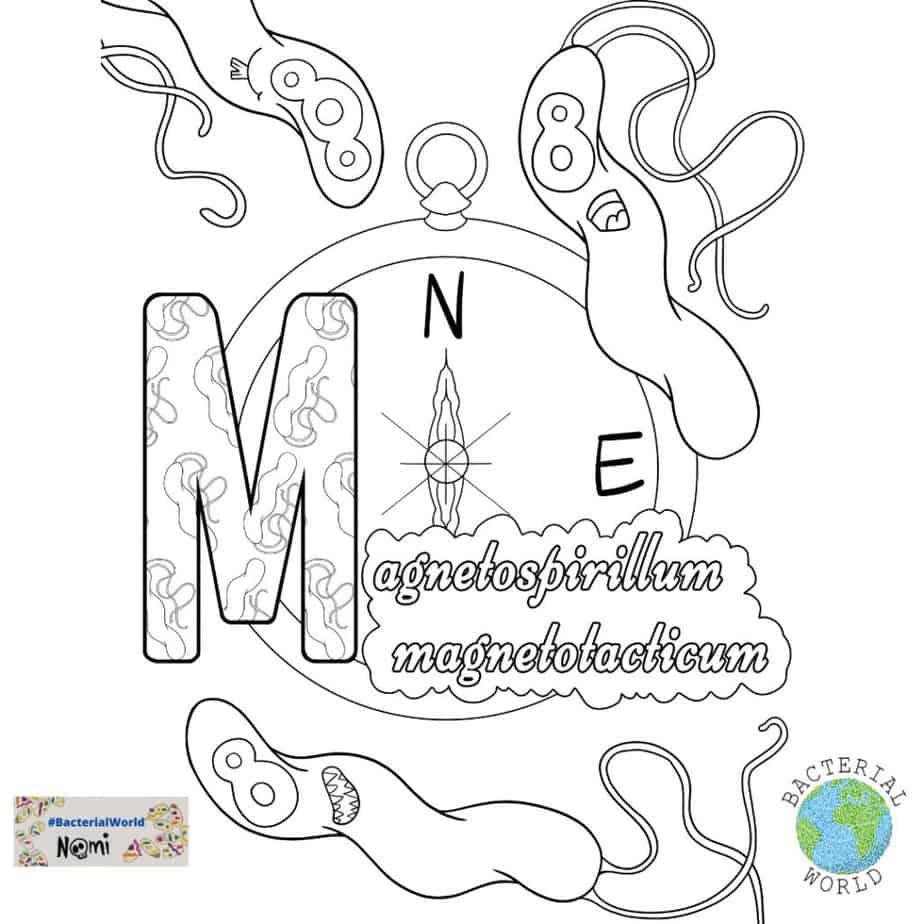
Okay, now we know what magnetotactic bacteria are. Let’s look at what gives magnetotactic bacteria their superpowers to read magnetic field lines.
What are magnetosomes?
Magnetotactic bacteria can sense magnetic field lines because they have so-called magnetosomes.
Magnetosomes are tiny crystals of iron oxide or iron sulfide. And these crystals are surrounded by a lipid membrane within a so-called organelle. Magnetosome organelles lie within the bacterium and import and export iron from the bacterial cytosol.
These magnetosomes can have different shapes and sizes. Some crystals are cuboctahedral, prismal-shaped or even bullet-shaped. Like the super cool magnetosomes in the pictures below.
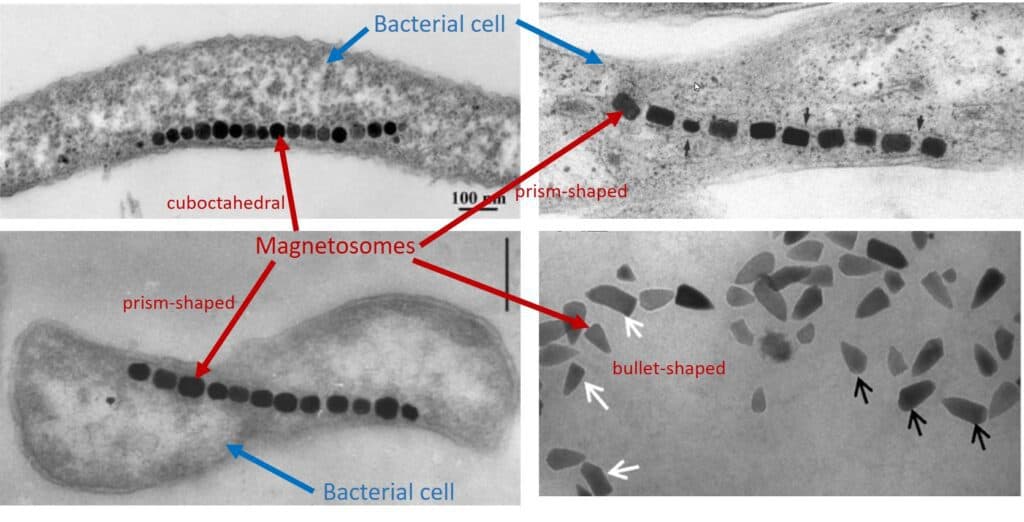
As you can see in the pictures, bacteria do not only have one magnetosome but several. And these magnetosomes can align in a perfectly straight line or cluster together on one side of the bacterium.
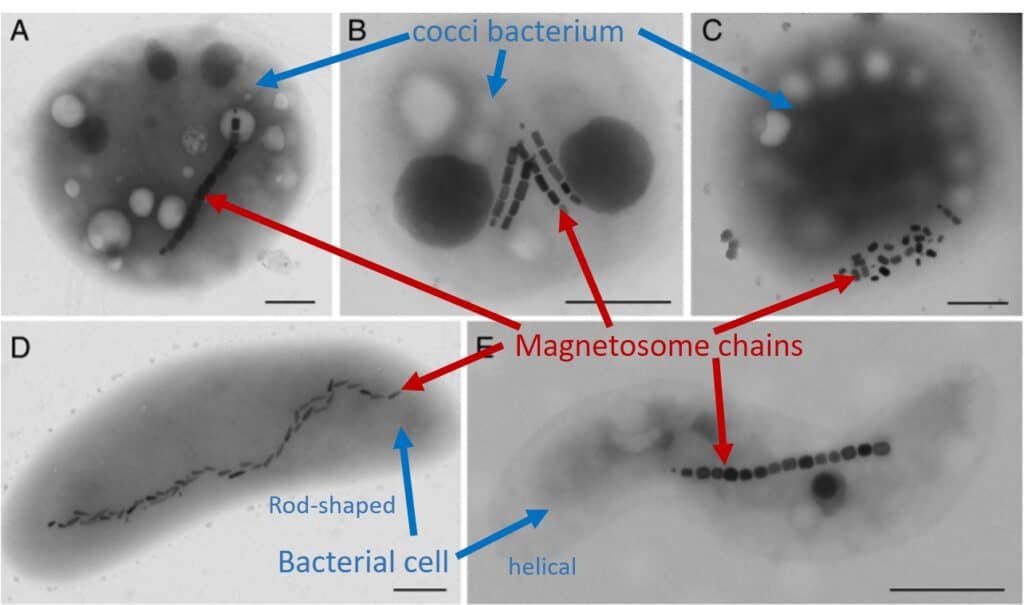
For a magnetosome chain or cluster to work, bacteria need to keep their shapes perfectly. For this, magnetotactic bacteria use so-called scaffold proteins. These scaffold proteins position the magnetosome within the bacterium and hold this chain in its place.
How do magnetotactic bacteria grow magnetosomes?
Because magnetosomes are made of iron, magnetotactic bacteria have very special iron uptake systems. These iron importers help the bacteria get as much iron into the cell as possible.
Then the bacterium needs to transport the iron toward the magnetosome. The problem is that free iron is actually toxic to the cell.
Hence, the bacterium needs to assure the iron does not come into contact with the cell content. Therefore, magnetotactic bacteria produce iron transporters that shield the iron from the surrounding.
Now, the bacterium needs to carefully crystallise the iron to grow the magnetosome. This process is actually not well understood yet and researchers are on it to shed light on it.
Okay, now we know what magnetosomes are and how they are formed. Let’s look at how magnetosomes help bacteria sense the Earth’s magnetic field.
How do magnetotactic bacteria sense magnetic field lines?
Because magnetosomes are highly-concentrated iron crystals, they have a magnetic dipole. And since a bacterium has many magnetosomes aligned in a straight line, the magnetic dipole is increased.
So, the magnetosome chain works similarly to a compass needle and aligns along magnetic field lines. Just as a compass needle aligns with magnetic field lines and you align your position according to the compass needle.
And we have the scaffolding proteins that keep the magnetosome chains in place within the bacterium. Because of them, the whole bacterium aligns with the magnetosomes. So, when you think about it; the bacterium aligns with the magnetic field lines in a passive way.
Imagine you put a worm on a compass needle that it can’t move away from. The compass needle will always point North and thus the worm will always point North as well. So, no matter where the compass goes or how fast you turn yourself with that compass, the needle and the worm will always face north. But the worm is only aligning North passively. Same as the bacterium.
As we said at the beginning, magnetotactic bacteria always have a flagellum that helps them swim around. Similar to other motile bacteria, a bacterium swims because it rotates its flagellum. This moves the bacterium forward or backward.
But since the magnetotactic bacterium is aligned to the North or South, it will only swim toward the North or South.
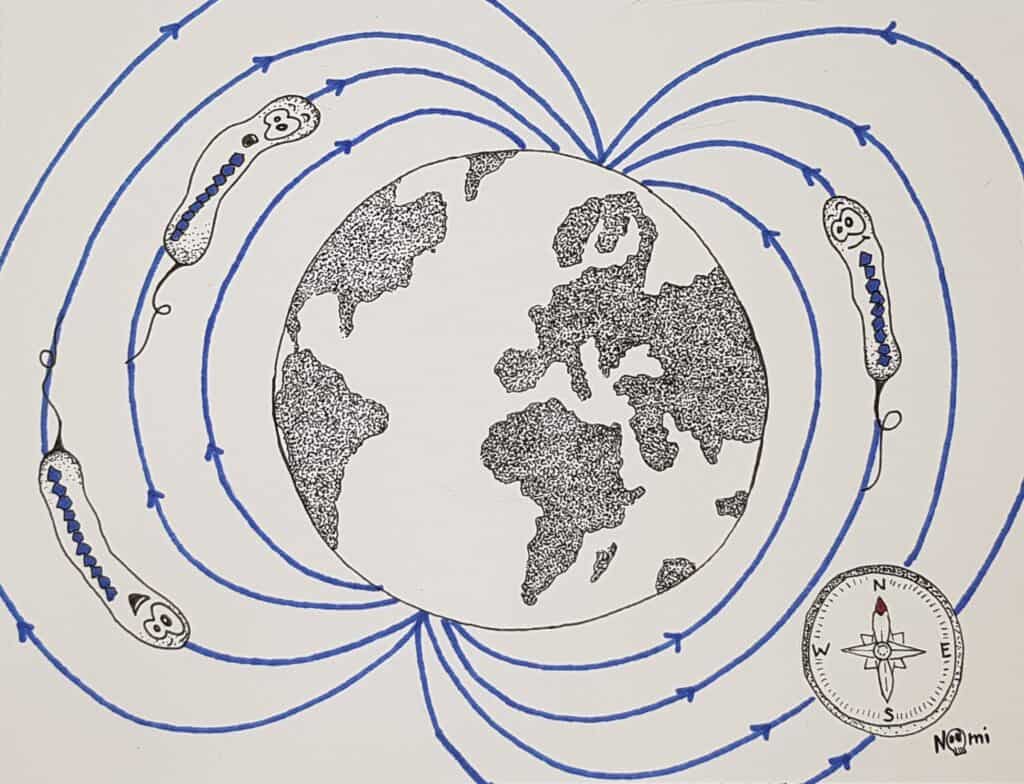
And researchers found that magnetotactic bacteria can be either North-bound or South-seeking. Hence, depending on whether the bacterium lives in the northern or southern hemisphere, it will swim towards the North- or the South pole.
So, next time you want to hitchhike on a magnetotactic bacterium, ask it first where it is going!
Why do magnetotactic bacteria sense magnetic field lines?
Researchers do not have a clear answer to this one yet.
One hypothesis is that within the depth of the water, a bacterium has three dimensions to align to, swim to and explore. By aligning the bacterium to the Earth’s magnetic field, the bacterium only moves in one dimension. This makes the search for the perfect location easier. Otherwise, bacteria might swim aimlessly in all three dimensions and get lost.
Also, most magnetotactic bacteria are chemotactic and even aerotactic. This means they move towards oxygen – again to find the perfect spot to live and to find nutrients.
And some magnetotactic bacteria are even phototactic and swim away from blue light. Researchers think that because blue wavelengths are a sign of deep water, bacteria are trying to avoid going too deep. But this still needs some more research.
Do magnetotactic bacteria help other organisms?
Researchers found an amazing example of a symbiotic relationship in the microbial world.
They discovered magnetotactic bacteria that live on a eukaryotic protist. The two species exchange metabolic molecules, so they feed each other.
What I find really fascinating is that these two species together become a swimming magnetic superorganism. The researchers saw that the magnetotactic bacteria completely cover the surface of the protist. And because the magnetotactic bacteria have magnetosomes, they align with the magnetic field. Thus, the entirety of bacteria on the protist aligns the whole protist with the magnetic field.
Interestingly, this species of magnetotactic bacteria lost their flagella during evolution. So they are unable to swim. But the protist still has a swimming rotor. Thus, because of the symbiosis, this multi-organism is able to sense and swim along the magnetic field lines.
Magnetotaxis – a bacterial superpower
Okay, I hope I could convince you yet again how amazing bacteria are and that they do have superpowers.
Again, it is not a hundred percent clear yet, how sensing magnetic field lines help bacteria to survive. But as usual with evolution, if some species kept such an impressive superpower, it must have a big advantage.
We just don’t understand it yet.

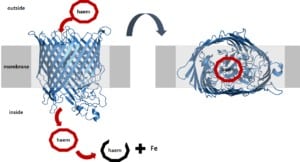
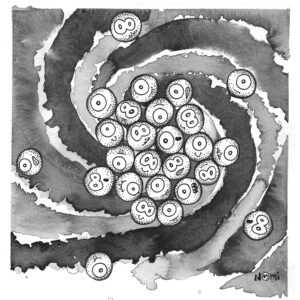





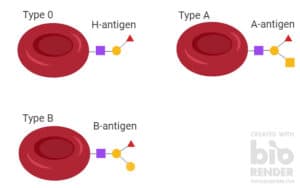
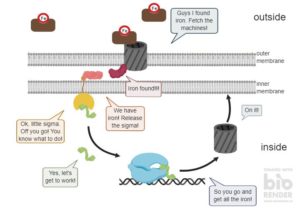


9 Responses
Amazing, as well as a new interdisciplinary scientific area such as bio-geophysics studying these phenomena.
Thank you :)
Thanks for this plain language explanation. I enjoyed reading it. ?
Thank you. I am glad you enjoy reading my articles.
every heart has a substantial magnetic field and is connected to gut bacteria via vague nerve relay – what makes You think this is only limited to geomagnetic fields? may be interesting to think of bacterial responses to biomagnetic fields including heart and brain given the magnitude of gut feeling response from communication involving emotional cognition
https://www.researchgate.net/figure/The-hearts-magnetic-field-which-is-the-strongest-rhythmic-field-produced-by-the-human_fig11_293944391/amp
https://pubmed.ncbi.nlm.nih.gov/21457072/ (DNA is a fractal antenna in electromagnetic fields)
https://arxiv.org/pdf/1104.3113.pdf (electromagnetic signals from bacterial DNA)
https://www.ncbi.nlm.nih.gov/m/pubmed/29347499 (synchronized rotation in swarms of magnetotactic bacteria)
Wow, this is a super interesting idea and I haven’t even thought about this. This is definitely worth looking into, so I thank you very much for making me aware of this question.
for sure – may also be interesting to think of the collisions happening between electromagnetic waves of each gut bacteria entity
My thoughts are that the bacteria also use cryptochromes responding to red green and blue light along with the magnetic polarity of each and that the bacteria are capturing emotions from others whom the host is entrained or in phase with
it seems that every word when polarized (figuratively and magnetically) carries a wavelength and that every life holds an angle on each word and that the angle influences the spin (figuratively and electrically) that the bacteria correlate to the host after reception of signals from a combination of radio waves transmitted from brain and heart waves
probably there is a base wavelength in any gene and these emissions are happening wherever the gene is on a host be it in bacteria or in surrounding cells or even on an inert surface and it seems that genes in surrounding cells are surrogate to the register of spin currently checked in to the bacteria since the bacteria are their own entities and the vagus relays signals from the solar plexus (maybe a sort of periscope for gut bacteria) to other nerve axes branching from the vague including the cardiac plexus splenic plexus gut-liver axis gut-brain axis etc – it may be that the heart instructs and entrains the gut bacteria to divide and conquer a stakeholdership in the cells of the organs surrounding the stomach
after the register of radio wave interference on gut bacteria by way of radio wave transmission from genes and neurons in heart and or brain there is also the ionosphere and its resonance which seems to be on similar wavelengths to alpha waves and the bacteria’s electromagnetic signaling
because the electrons are donated from the planet’s electric field (and originally of Sun) a phase alignment and misalignment arises with misalignments causing heating of the ionosphere and because the heated ionosphere responses the troposphere it’s possible that the out of phase or misaligned emissions from electromagnetic fields of bacteria causes climate change (chemical changes are also induced by way of hydrogenation nitrogenation hydrolysis etc)
check out software over at metabolism.munch.life and storyofgaia.munch.life to get a hold on these transmissions by using interferometry and spectroscopy – the premise is to send out a bluetooth reference signal from a phone and sift spectral response on nucleotides and amino acids based on phase modulation of locations interfered with by the outgoing bluetooth reference signal
https://www.sciencemag.org/news/2015/04/physicists-detect-radio-waves-single-electron
https://www.ncbi.nlm.nih.gov/pmc/articles/PMC102721/ (bacterial cryptochrome and photolyase)
https://en.m.wikipedia.org/wiki/Cryptochrome#Evolutionary_history_and_structure (sensitive to blue light and possibly also in the sensing of magnetic fields
https://en.m.wikipedia.org/wiki/Schumann_resonances
https://en.wikipedia.org/wiki/Wave_interference